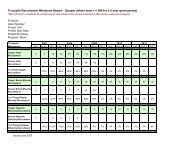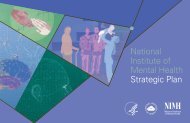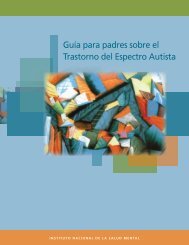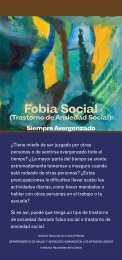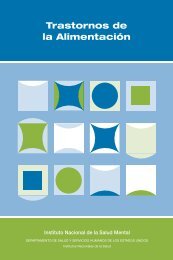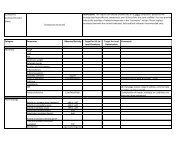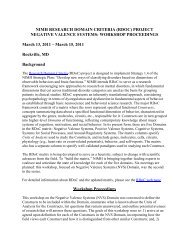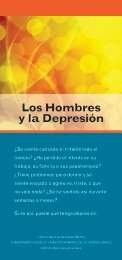Brain's Inner Workings: Teacher's Manual - NIMH
Brain's Inner Workings: Teacher's Manual - NIMH
Brain's Inner Workings: Teacher's Manual - NIMH
Create successful ePaper yourself
Turn your PDF publications into a flip-book with our unique Google optimized e-Paper software.
Visualizing the Nervous System<br />
Continue with the 5-minute video The Brain’s <strong>Inner</strong> <strong>Workings</strong> Part I. This introductory video narrated by<br />
Leonard Nimoy provides outstanding visuals to introduce students’ study. The following brief summary<br />
can provide some suggestions for discussion: The video begins with a collage of learned responses. This<br />
is a good segment to view, discuss, then repeat. It sets the tone for the more technical material that follows.<br />
A student plays piano, kicks a ball, plays chess. Brainstorm: What are the stimuli involved? (Sight, sound)<br />
What are the responses? (Muscle movements, higher cognitive functions) What must be learned? Is any of<br />
the activity inborn or instinctive? (A blink or a reflex as a ball approaches could be inborn, but most of the<br />
actions are learned.)<br />
The narrator then speculates on what “makes humans human?” and attributes that quality to the brain’s<br />
cerebral cortex. This is another great place for students to brainstorm their own definitions of activities that<br />
might be functions of a human brain:<br />
• Tool use? It’s also found in other primates and birds.<br />
• Culture? The passing down of behaviors through social connections has been documented<br />
in many animals including cetaceans.<br />
• Emotions? Many new studies show emotional responses in animals such as dogs<br />
and elephants.<br />
Yet all of these animals, like humans, have complex brains with folded cerebral cortexes. The extent of<br />
folding seems to correspond at least to some degree with intelligence. The narrator suggests that the folding<br />
is a way to create more surface area in a limited space. First, ask students: “Why is the space limited?” Two<br />
logical reasons will easily be generated: There is a physical limit to the weight of the head, and the size of<br />
the head is limited by the need to pass through the birth canal in hips which are functional for walking.<br />
Students may suggest other reasons, such as to turn the head for defense.<br />
The video next moves to show the structure of neurons within the brain. Students may be familiar with<br />
a drawing of a neuron with one long axon and one or two short dendrites; they may be surprised by the<br />
many contacts among these cells. Key terms in the video (Cerebrum, cortex, neuron, axon, dendrite,<br />
process, synapse and synaptic vesicle) are defined in the glossary. The video ends with a summary of why<br />
this research—and the student explorations which will follow—are important. Ask students if they’ve had<br />
any experience with brain disease, and indicate that they will learn more in the activities that follow. The<br />
student guide helps focus their work on decision-making skill.<br />
Don’t expect students to get every detail of the video on first viewing. Its five-minute format makes it ideal<br />
for repeat viewing. The worksheet provided on the next page only asks for general observations. Then return<br />
to the video again. Students will undoubtedly find more to notice on second viewing. You can review the<br />
structure of the neuron in the “Nerves” animation on the companion CDROM.<br />
Finally, the students can explore simple reflexes in the activity Take That!<br />
6 The Brain’s <strong>Inner</strong> <strong>Workings</strong>: A Guide for Teachers<br />
Na t i o n a l Institute of Me n t a l He a l t h



